Digital Television
DBS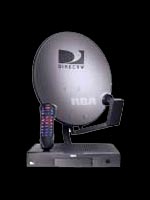 1990 by Hughes 1990 by Hughes
1080 hlines resolution
16:9 screen
1920x1080 dpi
DIRECTV
| DVD
1995 by DVD Alliance
540 vlines resolution
4:3 or 16:9 screen
720x480 dpi
Digital Video Disc
| SDTV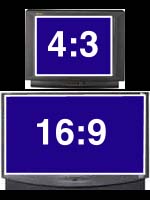 1996 by ATSC 1996 by ATSC
480 hlines resolution
4:3 screen
704x480 dpi
| HDTV-LoRes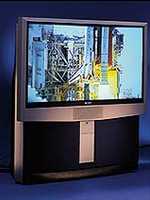 1996 by ATSC 1996 by ATSC
720 hlines resolution
4:3 screen
1280x720 dpi
| HDTV-HiRes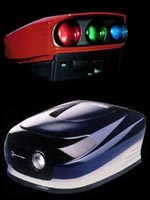 1996 by ATSC 1996 by ATSC
1080 hlines resolution
16:9 screen
1920x1080 dpi
Vidikron
|
1989 - International Telecommunications Union established the first HDTV standards, based on digital packet transmission rather than analog wave transmission.
1990- The RCA dog Nipper was joined by a smaller canine companion named Chipper, who represented the semi-conductor-based future of digital consumer electronics.
1993 - Digital HDTV Grand Alliance was created to develop prototype digital high definition television equipment. Thomson introduced CinemaScreen, the first widescreen TV available in the U.S. (but analog, not yet digital). Thomson Consumer Electronics was created by the 1988 purchase of RCA and GE consumer electronics businesses from General Electric.
1994 - RCA Digital Satellite System (DSS) became North America's first high-power direct broadcast satellite (DBS) consumer television system, with DIRECTV, started by Hughes Electronics Corporation in 1990 in the Ku-band of the radio spectrum, and three Hughes HS 601 satellites relaying 200 channels to any 18-inch dish in North America.
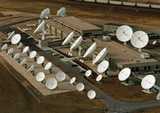 Uplink center from DISH Uplink center from DISH |
1995 - Dec. 28, EchoStar launched its first Direct Broadcast Satellite, EchoStar I, and DISH (Digital Sky Highway) Network came to life on March 4, 1996. The EchoStar Communications Corporation was founded in 1980 by Charlie Ergen, his wife Candy Ergen and Jim DeFranco, to supply direct-to-home (DTH) television products in the large-dish C-band of the radio spectrum. EchoStar V was launched by International Launch Services September 23, 1999, and will begin Nov. 29 broadcasting local channels to 13 selected cities. 1996 - In December, the FCC approved HDTV standards proposed by the Advanced Television Standards Committee (ATSC) that was formed in 1983 to replace the analog standards of the NTSC. Each HDTV channel has been allocated a bandwidth of 6 MHz for a theoretical data rate of 19 Mbps (but actual rates of 14.7 to 17.9 fall short of the 18 Mbps required for fast-moving sports broadcasts, and less that the 24 Mbps needed for 1080p). This allowed transmission of different digital signals, from 480 to 1080 interlaced lines of resolution (but not 1080 progressive lines), and from 640x480 dpi (300,000 pixels) at 4:3 normal screen ratio to 1920x1080 dpi (2 million pixels) at 16:9 widescreen ratio.
1998 - Jan. 7, DIRECTV and Thomson Consumer Electronics demonstrated at the annual International Consumer Electronics Show the first satellite transmission of HDTV program material. In August, RCA introduced the DCT100 digital receiver for $649 that allowed digital and analog signals to be viewed on any set. Terrestial digital television broadcasting began in November using the 8-VSB standard recommended by ATSC and approved by the FCC in 1996. Tests in Philadelphia by Sinclair Broadcasting indicated this standard was inferior to the more expensive but more reliable COFDM standard used in Europe.1999 - March 6, HBO began HDTV satellite broadcast of motion picture films, starting with "U.S. Marshalls" at 8 pm. By November, 70 of America's 1600 TV stations were broadcasting HDTV and 88,000 sets had been sold. DIRECTV added a second HDTV satellite channel Nov. 1.
History of Radio | History of Television | Network TV | Golden Age TV | Split-Personality TV | Satellite TV | Digital TV | Television Sources and Links
© 1999 by Steven E. Schoenherr. All rights reserved.
|
Return to Recording Technology History Notes | this page revised Dec. 10, 1999



